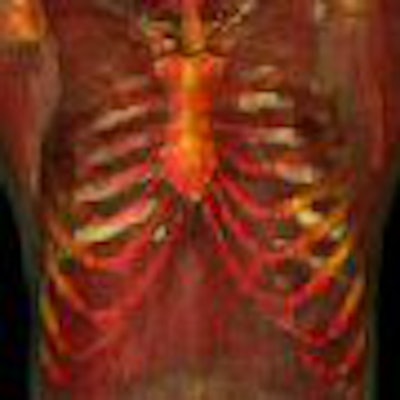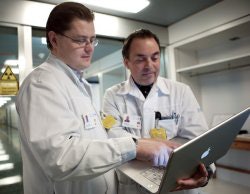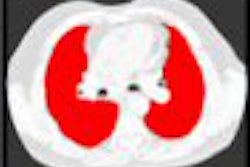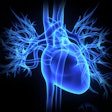
Is it a software product or a movement? That's the existential dilemma faced by the founders of OsiriX, an open-source software program for viewing medical images. The software's developers are trying to find ways to further popularize OsiriX as it carves out a unique niche in a market dominated by large firms with proprietary PACS applications.
 |
| OsiriX founders Dr. Antoine Rosset (left) and Dr. Osman Ratib. |
Ratib was frustrated by the inability of PACS software at the time to handle large datasets, and thought he could build a better mousetrap. While at UCLA, he enlisted the aid of Dr. Antoine Rosset, a radiology resident and computer programmer who was also from Switzerland, to develop a homegrown application for viewing DICOM-based medical images.
At an early stage, Ratib and Rosset decided to base their work on open-source software code, which can be shared and improved upon by anyone. They also decided to run the software exclusively on Apple Macintosh computers, due to the graphics capabilities of these machines. The first official version of OsiriX became available in early 2005.
Early on, OsiriX required graphics accelerators to achieve the required performance levels for sophisticated imaging datasets, but the current generation of Macintosh systems, with multicore processors now available, is powerful enough to get the job done with additional hardware acceleration, Ratib said.
An online community
Now, OsiriX has a user base of at least 25,000 users (as measured by unique Internet Protocol [IP] addresses). That number is almost certainly higher as it doesn't include those users behind firewalls, whose IP addresses are hidden, Ratib said. The software is available for free download at www.osirix-viewer.com.
OsiriX users can contribute to the software's development though SourceForge, an online repository of open-source software code. Individuals can sign up to modify OsiriX, and if their application is approved by Rosset, they then get access to the source code.
SourceForge allows multiple versions of OsiriX to be developed simultaneously. Ultimately, Rosset reviews and debugs contributions, and determines what goes into the next version of the software. One new major version is typically released each year, with a major feature of the current release, version 3, being support for Apple's new Leopard operating system for the Macintosh.
 |
| OsiriX whole-body 3D rendering from a CT dataset obtained from a 64-slice PET/CT scanner. |
The software is also easy to use, making it accessible to nonradiologists -- historically, a group overlooked by vendors of proprietary PACS software, he noted.
"OsiriX is convenient for people outside radiology," Ratib said. "We're ahead of the industry in showing that these users need more powerful software."
Next steps
OsiriX has also found a niche among academic institutions, where many researchers see it as an intriguing development platform. Applications developed by third parties can easily be integrated into OsiriX as plug-ins, Ratib said, and firms have developed plug-ins ranging from quantitative MRI measurement of the brain to coronary analysis with CT data.
Even commercial versions of OsiriX have become available. PACS firm aycan Medical Systems of Rochester, NY, has developed a commercial version of OsiriX, called workstation OsiriX Pro, that has received U.S. Food and Drug Administration (FDA) clearance.
FDA clearance is a particularly thorny issue for OsiriX that may have prevented more widespread use of the software, particularly in the U.S. Because the software is open-source and isn't controlled by any single vendor, noncommercial versions of the software have not gone through the FDA clearance process.
Some OsiriX aficionados have been told -- in some cases by developers of proprietary PACS software -- that using a non-FDA-approved product for primary diagnosis could open them up to legal liability, Ratib said. Ratib noted that the FDA clearance process is actually a method for regulating how and when vendors can market products, rather than a method for regulating how physicians can practice medicine.
As a means of helping OsiriX deal with this and other issues, Ratib, Rosset, and other investors have started the OsiriX Foundation, a nonprofit entity designed to help guide OsiriX through the next stages of its development. They plan to start the foundation with a seed grant of 50,000 to 100,000 Swiss francs ($51,000 to $101,000 U.S.).
The foundation will help formalize the process involved in vetting the various OsiriX code additions that are developed around the world, and determining which contributions are added to the next version of the software, Ratib said. This process is currently handled by Rosset, but it's becoming too much for just one individual.
Once the foundation is set up, in the next three to six months, it will issue a call for grant applications with the goal of hiring one or two fellows in the first year. The fellows will be responsible for training, support, development, and other responsibilities related to OsiriX.
"Open source can become hectic if everyone puts code in there and no one controls it," Ratib said. "Antoine spends a lot of time going through each version. It is becoming more and more difficult for one person to do that, and we need a structure to support that and to support users."
By Brian Casey
AuntMinnie.com staff writer
March 25, 2008
Related Reading
Apple, Totoku, OsiriX partner on digital mammo workstation, March 5, 2008
Copyright © 2008 AuntMinnie.com



















